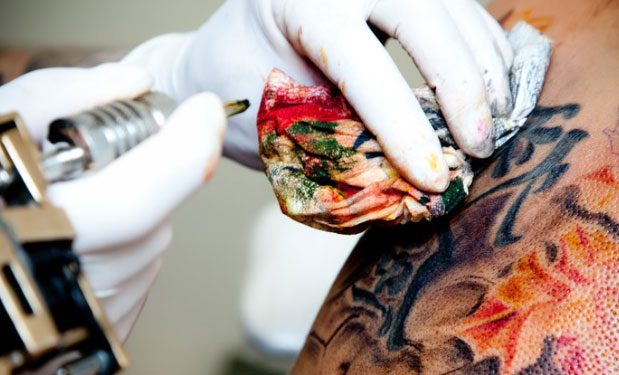What Happens After You Get a Tattoo? Why does the tattoo ink on our bodies not fade away while skin cells are constantly dying and being replaced?
Tattoo ink is injected into the dermis (the deeper layer of the skin) using a needle. The body views the ink as a foreign substance and tries to push it out of the skin; however, the chemical properties of the ink make this process quite difficult for the body. As a result, most colors remain in the skin.
The tattoo needle punctures the skin about 100 times per second, aiming to deposit ink in a region beneath the skin surface, approximately 1.5 to 2 mm deep. The reason for this is that this depth exceeds the outer layer of skin, known as the epidermis.

Ink injected into the surface layer of skin will disappear within 3 weeks.
The epidermis is the part of the skin that continuously renews itself. Every day, thousands of epidermal cells shed from the skin and are replaced by new ones. Ink injected into the surface layer of skin will disappear within 3 weeks.
To ensure that the ink remains permanently in the body, the tattoo needle must penetrate the epidermis into the deeper layer, the dermis. Nerves and blood vessels are located here, which is why tattooing can cause pain and bleeding.
Most tattoo pigments remain in the body after a person gets tattooed. The ink is not erased by specialized recovery and repair cells, known as macrophages. Dr. Arisa Ortiz, a dermatologist and director of the laser and cosmetic dermatology department at U.C. San Diego Health, states: “Typically, the ink does not move far from where it was injected. For the most part, the ink is engulfed by the skin or immune cells, and then surrounded by the gauze in the dermis.”
However, researchers are examining more closely the movement of tattoo ink to other parts of the body, particularly the lymph nodes.
Scientists have also discovered that some toxic heavy metals found in tattoo ink have traveled to the lymph nodes. Particles of cobalt, nickel, and chromium, which are sometimes added to organic inks as preservatives, have reached the lymph nodes.
Is it harmful to the body?
Other studies have indicated that tattoo pigments can migrate to other areas of the body. A study published in May 2017 in the journal Dermatology involved tattooing mice with black and red ink.
About a year later, the research team found ink pigments in the lymph nodes of the mice, similar to what happens in humans, and also in the liver cells.
“This is a very interesting and surprising finding,” said Mitra Sepehri, the lead author of the mouse study. “To reach the liver cells, the pigments must travel through the blood to the liver. Therefore, we have shown that tattoo pigments can spread through the blood system of mice as well as through the lymphatic system.”
Of course, mice are not humans, and as Sepehri pointed out, the study does not claim that human tattooing will lead to liver contamination with ink pigments. Additionally, because mouse skin is thinner than human skin, tattoo ink may be stored deeper in mice and is more likely to enter the bloodstream. Even if further research in 5 or 10 years shows that tattoo ink accumulates in the liver of humans, it is still uncertain whether this would cause any harm.
A study from Denmark in 2011 found that 10% of unopened tattoo ink bottles tested were contaminated with bacteria. Moreover, a 2012 study by the Danish Environmental Protection Agency found that 1 in 5 ink samples contained carcinogenic substances.
“Humans have been tattooing for thousands of years, and clearly, this practice will continue,” Ortiz said. “Therefore, we need more research, both on the tattooing process and the inks, to understand potential reactions in the skin, to optimize safety during tattooing.”




















































